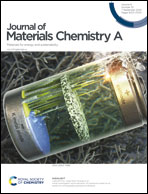Rational design of NiFe LDH@Ni3N nano/microsheet arrays as a bifunctional electrocatalyst for overall water splitting†
Abstract
Low-cost, efficient and stable electrocatalysts are required for large-scale production of hydrogen by industrial scale water electrolysis. We report here a hybrid bifunctional electrocatalyst, composed of amorphous NiFe LDH nanosheets and metallic Ni3N microsheet arrays grown on Ni foam for water splitting in alkaline electrolyte. This electrocatalyst possesses a typical 3D hierarchical heterostructure architecture and affords abundant exposed active sites. The strong coupling and synergistic effects between the NiFe LDH nanosheets and the Ni3N microsheet arrays provide a robust integrated structure and fast electron transfer. The superhydrophilic/superaerophobic properties of the electrocatalyst promote the mass transfer particularly at a large current density. By employing the NiFe LDH@Ni3N/NF as a bifunctional electrocatalyst for overall water splitting, an alkaline aqueous electrolyzer exhibits a low cell voltage of 1.80 V at a current density of 500 mA cm−2 with a remarkable durability of 100 h. The bifunctional NiFe LDH@Ni3N/NF electrocatalyst is a very promising candidate for scale-up industrial implementation of hydrogen production due to its excellent catalysis activity and high stability.



 Please wait while we load your content...
Please wait while we load your content...